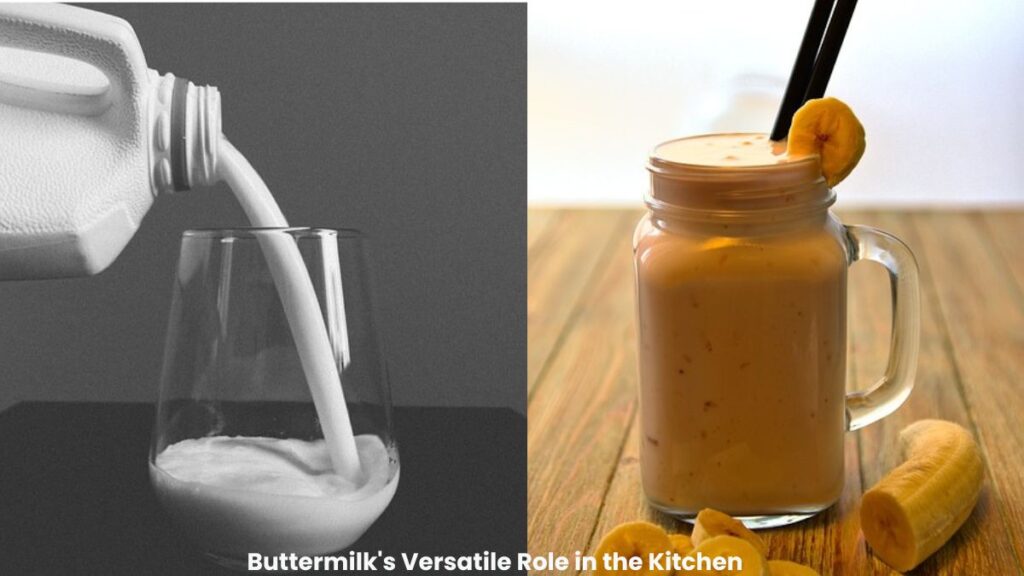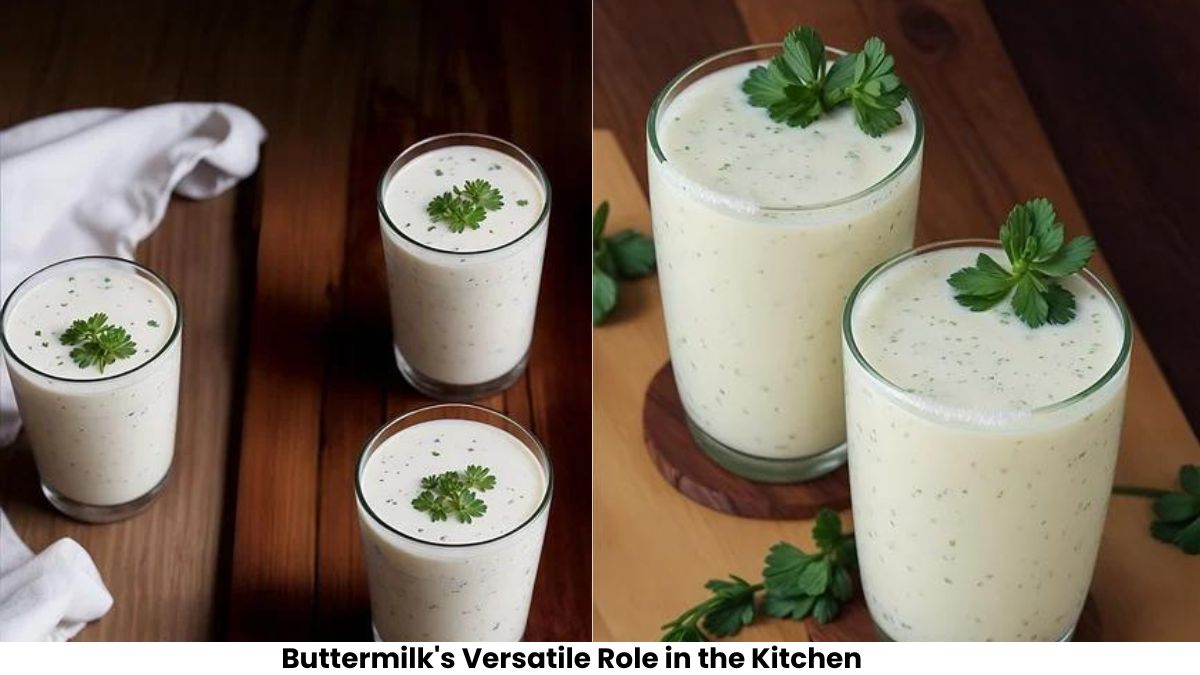Introduction:
Beyond Baking: Buttermilk’s Versatile Role in the Kitchen
Buttermilk has long been associated with baking, known for its ability to tenderize and add a delightful tang to cakes, biscuits, and pancakes. However, its culinary potential extends far beyond the realm of baked goods. In this article, we’ll explore the diverse and versatile role that buttermilk plays in the kitchen, from savory dishes to refreshing beverages, highlighting its unique flavor profile and culinary benefits.
Exploring Buttermilk’s Tangy Depth:

Unlike its name suggests, buttermilk is not simply the residue left after churning butter. Modern buttermilk is typically cultured, resulting in a tangy, slightly acidic flavor profile that adds depth and complexity to dishes. This tanginess makes it a versatile ingredient that can enhance both sweet and savory recipes.
Savory Applications: One of the most underrated uses of buttermilk is in savory cooking. Its acidity helps tenderize meat, making it an excellent marinade for fried chicken or pork chops. The enzymes in buttermilk also work to break down proteins, resulting in juicier, more flavorful meat. Additionally, buttermilk can be used as a base for creamy dressings and dips, adding a subtle tanginess that complements fresh herbs and spices beautifully.
Refreshing Beverages: Buttermilk isn’t just for cooking—it also shines in refreshing beverages. In many cultures, buttermilk is enjoyed on its own as a cooling drink, particularly in hot climates. Mixed with a pinch of salt and a dash of spices like cumin or mint, buttermilk becomes a revitalizing thirst-quencher that pairs perfectly with spicy foods or as a standalone refreshment on a hot summer day.
Health Benefits: Beyond its culinary versatility, buttermilk also boasts several health benefits. It is rich in probiotics, which promote a healthy gut microbiome and aid in digestion. Additionally, buttermilk is lower in fat and calories compared to whole milk, making it a lighter alternative for those watching their calorie intake.
How does buttermilk affect the texture of fried chicken?
Buttermilk has a significant impact on the texture of fried chicken, making it juicier and more flavorful. When chicken is soaked in buttermilk before frying, several processes occur that contribute to its texture:
- Tenderization: The acidity of the buttermilk helps to break down the proteins in the chicken, resulting in a more tender and succulent texture. This process is especially beneficial for tougher cuts of meat or chicken, ensuring that they remain moist and tender after frying.
- Flavor infusion: Buttermilk is not only acidic but also contains fat, which helps to carry flavor molecules into the chicken. As the chicken marinates in the buttermilk, it absorbs the tangy and rich flavor of the buttermilk, enhancing its taste.
- Coating adherence: The buttermilk serves as an excellent binding agent for the coating of the fried chicken. After soaking in buttermilk, the chicken is typically dredged in seasoned flour or breadcrumbs before frying. The buttermilk helps the coating adhere more effectively to the chicken, resulting in a crispy and golden exterior.
Overall, buttermilk plays a crucial role in achieving the desired texture and flavor profile of fried chicken, making it a popular choice for marinating this classic dish.
What types of dishes can be made more tender with buttermilk marinades?
Buttermilk marinades are incredibly versatile and can be used to tenderize a wide range of dishes, particularly those containing meat or poultry. Here are some examples of dishes that can benefit from buttermilk marinades:
- Fried Chicken: Buttermilk is a classic marinade for fried chicken, helping to tenderize the meat while also adding flavor. The acidity of the buttermilk breaks down proteins in the chicken, resulting in a juicier and more tender texture.
- Pork Chops: Buttermilk marinades are also excellent for tenderizing pork chops before grilling or frying. The acidity of the buttermilk helps to break down the tough muscle fibers in the meat, resulting in a more tender and flavorful dish.
- Beef Steak: While buttermilk is more commonly associated with poultry, it can also be used to tenderize beef steak. Marinating steak in buttermilk helps to tenderize the meat and infuse it with flavor, resulting in a juicy and succulent steak.
- Lamb: Buttermilk marinades can also be used to tenderize lamb before grilling or roasting. The acidity of the buttermilk helps to break down the connective tissues in the meat, resulting in a more tender and flavorful dish.
- Vegetables: Buttermilk marinades aren’t just for meat—vegetables can also benefit from marinating in buttermilk. For example, buttermilk can be used to tenderize and flavor vegetables like cauliflower or eggplant before roasting or grilling.
Overall, buttermilk marinades are a versatile and effective way to tenderize a variety of dishes, adding flavor and moisture in the process. Whether you’re cooking meat, poultry, or vegetables, buttermilk can help you achieve tender and delicious results.
Can buttermilk be used in savory and sweet recipes?
Yes, buttermilk can be used in both savory and sweet recipes, thanks to its versatile flavor profile and acidity. Here’s how it can be utilized in each category:

- Savory Recipes:
- Marinades: Buttermilk is commonly used as a marinade for meats such as chicken, pork, and even lamb. Its acidity helps tenderize the meat while also imparting flavor.
- Dressings and Sauces: Buttermilk can be used as a base for creamy dressings and sauces, such as ranch dressing or tzatziki sauce. Its tangy flavor adds depth to savory dishes.
- Soups and Stews: Buttermilk can be added to creamy soups and stews to provide richness and a slight tanginess. It pairs well with ingredients like potatoes, leeks, and herbs.
- Biscuits and Scones: While often considered a savory side dish, biscuits and scones made with buttermilk can have a slightly sweet flavor and are versatile enough to be served with savory dishes like gravy or soup.
- Sweet Recipes:
- Baking: Buttermilk is a common ingredient in baking, particularly in recipes like cakes, muffins, and pancakes. Its acidity reacts with baking soda to help baked goods rise and become tender.
- Frostings and Icings: Buttermilk can be incorporated into frostings and icings to add a tangy flavor and a creamy texture. It pairs especially well with ingredients like cream cheese or buttercream.
- Pies and Tarts: Buttermilk can be used in custard-based pies and tarts to add richness and a subtle tanginess. It’s often featured in recipes like buttermilk pie or lemon buttermilk tart.
- Frozen Treats: Buttermilk can be used to make refreshing frozen treats like ice cream or sorbet. Its tangy flavor adds complexity to these desserts and helps balance out the sweetness.
In summary, buttermilk is a versatile ingredient that can be used in a wide range of savory and sweet recipes, adding flavor, moisture, and a slight tanginess to dishes across the culinary spectrum.
What are some of the benefits of using buttermilk in cooking?
Using buttermilk in cooking offers several benefits, both in terms of flavor enhancement and nutritional value. Here are some of the advantages of incorporating buttermilk into your cooking:
- Tenderizes Meat: The acidic nature of buttermilk helps to tenderize meat, making it ideal for marinating tougher cuts like chicken breasts or pork chops. This tenderizing effect results in juicier and more flavorful meat dishes.
- Adds Tangy Flavor: Buttermilk’s tangy flavor adds depth and complexity to dishes, enhancing their overall taste profile. Whether used in marinades, dressings, or baked goods, buttermilk contributes a subtle yet distinct flavor that elevates the dish.
- Moisture Retention: In baking, buttermilk helps to retain moisture, resulting in softer and more tender baked goods. Its acidic properties react with baking soda to produce carbon dioxide, which helps the dough or batter rise and creates a lighter texture.
- Nutritional Benefits: Buttermilk is rich in essential nutrients such as calcium, potassium, and vitamin B12. It also contains probiotics, which promote a healthy gut microbiome and aid in digestion. Opting for buttermilk in cooking can therefore contribute to a more balanced and nutritious diet.
- Versatility: Buttermilk is a versatile ingredient that can be used in both savory and sweet recipes. From marinades and sauces to pancakes and muffins, buttermilk adds a unique flavor and texture to a wide range of dishes, making it a valuable staple in the kitchen.
- Reduces Fat Content: Compared to whole milk or cream, buttermilk has a lower fat content, making it a lighter option for cooking without sacrificing flavor or texture. This makes it suitable for those looking to reduce their calorie or fat intake without compromising on taste.
Overall, incorporating buttermilk into your cooking can enhance the flavor, texture, and nutritional value of your dishes, making it a beneficial ingredient to have on hand in the kitchen.
In Conclusion:
Buttermilk’s versatility in the kitchen goes far beyond its role in baking. From tenderizing meats to adding a tangy kick to dressings and beverages, this humble ingredient proves to be a culinary powerhouse. Whether you’re looking to experiment with new flavors or simply seeking a refreshing drink on a hot day, buttermilk has something to offer for every palate and occasion. So, the next time you reach for this dairy staple, consider its potential to elevate your dishes to new heights of flavor and enjoyment.







I really like what you guys tend to be up too. This kind
of clever work and coverage! Keep up the awesome works guys I’ve
included you guys to our blogroll.
excellent points altogether, you just won a emblem new reader. What may you suggest about your submit that you simply made some days in the past? Any certain?